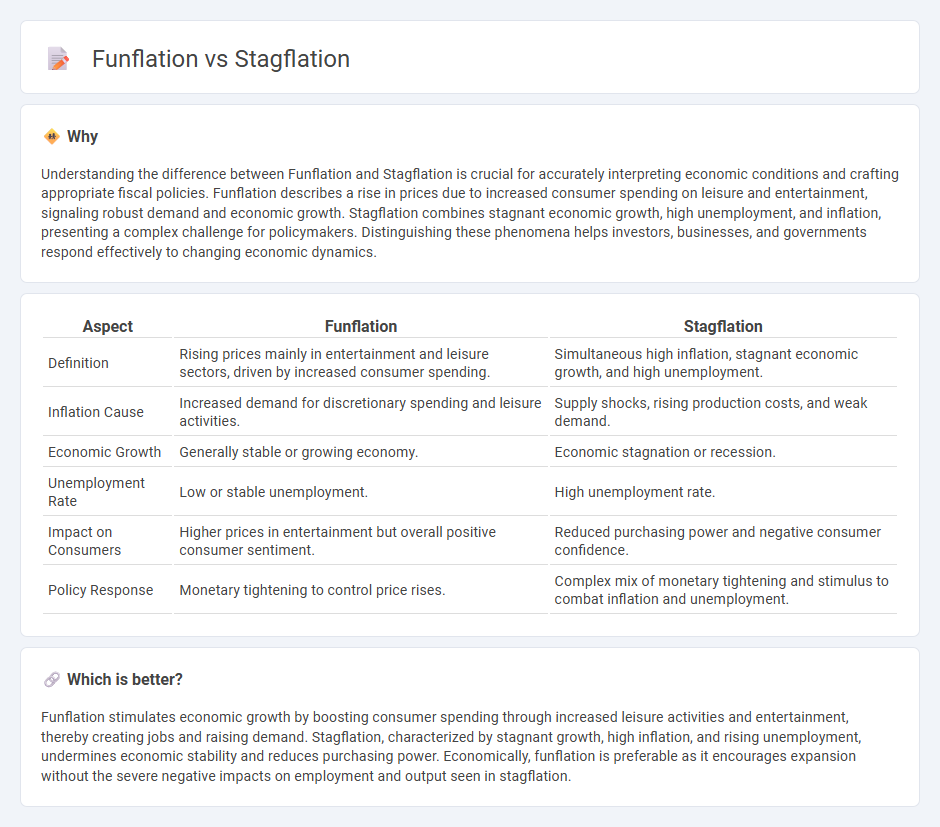
Funflation describes a rise in prices driven by increased consumer spending on leisure and entertainment activities, reflecting a buoyant demand despite inflation. Stagflation occurs when stagnant economic growth coincides with high inflation and unemployment, creating a challenging environment for policymakers. Explore the distinct impacts of funflation and stagflation on the economy to understand their critical differences.
Why it is important
Understanding the difference between Funflation and Stagflation is crucial for accurately interpreting economic conditions and crafting appropriate fiscal policies. Funflation describes a rise in prices due to increased consumer spending on leisure and entertainment, signaling robust demand and economic growth. Stagflation combines stagnant economic growth, high unemployment, and inflation, presenting a complex challenge for policymakers. Distinguishing these phenomena helps investors, businesses, and governments respond effectively to changing economic dynamics.
Comparison Table
| Aspect | Funflation | Stagflation |
|---|---|---|
| Definition | Rising prices mainly in entertainment and leisure sectors, driven by increased consumer spending. | Simultaneous high inflation, stagnant economic growth, and high unemployment. |
| Inflation Cause | Increased demand for discretionary spending and leisure activities. | Supply shocks, rising production costs, and weak demand. |
| Economic Growth | Generally stable or growing economy. | Economic stagnation or recession. |
| Unemployment Rate | Low or stable unemployment. | High unemployment rate. |
| Impact on Consumers | Higher prices in entertainment but overall positive consumer sentiment. | Reduced purchasing power and negative consumer confidence. |
| Policy Response | Monetary tightening to control price rises. | Complex mix of monetary tightening and stimulus to combat inflation and unemployment. |
Which is better?
Funflation stimulates economic growth by boosting consumer spending through increased leisure activities and entertainment, thereby creating jobs and raising demand. Stagflation, characterized by stagnant growth, high inflation, and rising unemployment, undermines economic stability and reduces purchasing power. Economically, funflation is preferable as it encourages expansion without the severe negative impacts on employment and output seen in stagflation.
Connection
Funflation and stagflation are connected through their impact on consumer behavior and economic growth during periods of inflation. Funflation, characterized by rising prices in entertainment and leisure sectors, highlights shifts in discretionary spending amid inflationary pressures seen in stagflation, where stagnant growth combines with high inflation and unemployment. Both phenomena underscore challenges in balancing inflation management with sustaining demand and economic stability.
Key Terms
Inflation
Stagflation refers to the economic condition characterized by stagnant growth, high unemployment, and rising inflation, creating a challenging environment for policymakers. Funflation, a more recent concept, describes rising prices driven by increased consumer spending on leisure and entertainment activities, reflecting stronger demand rather than supply shocks. Explore the differences and implications of stagflation and funflation to understand their impacts on inflation dynamics.
Economic Growth
Stagflation, characterized by stagnant economic growth, high inflation, and unemployment, poses significant challenges to economic stability and investor confidence. Funflation, a term describing rising prices driven by increased consumer spending on entertainment and leisure, reflects a more dynamic economic environment with potential for growth. Explore the distinctions between stagflation and funflation to understand their impact on economic development and market trends.
Unemployment
Stagflation presents a challenging economic scenario characterized by high unemployment, stagnant demand, and rising inflation, severely impacting labor markets. In contrast, funflation, a recent term describing inflation in leisure and entertainment sectors, often sees more stable employment due to continued consumer spending in discretionary areas. Explore the nuanced effects of these inflation types on unemployment rates and economic resilience.
Source and External Links
Overview, Examples, Why Stagflation is Feared - Stagflation is an economic condition defined by high inflation, slow economic growth, and consistently high unemployment, causing a dilemma for policymakers since measures to reduce inflation can increase unemployment and vice versa.
a stagflation primer - It describes a scenario where inflation remains high despite stagnating or declining GDP growth, often accompanied by rising unemployment and a high "misery index," illustrating the economic pain from this combination.
Stagflation - The term, coined in the 1960s, refers to the simultaneous occurrence of inflation, stagnant growth, and elevated unemployment, typically caused by supply shocks or poor economic policies, and presents a major challenge to traditional economic theory and policy responses.
 dowidth.com
dowidth.com